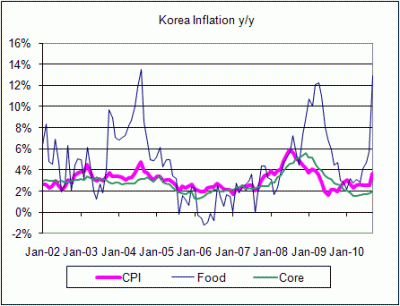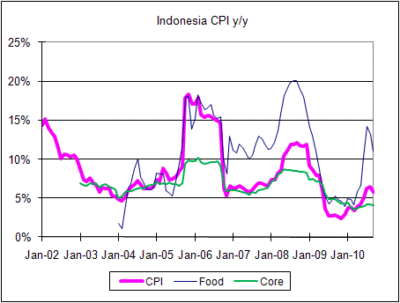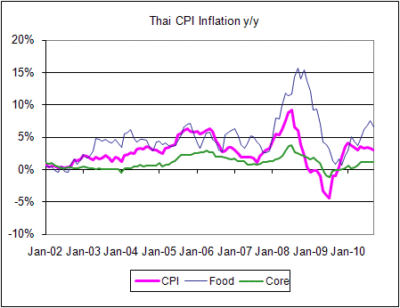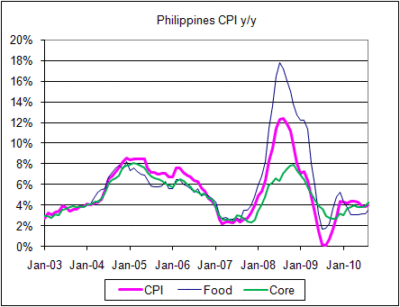Rising Food Prices Likely To Push EM Central Banks Into Tightening
From Win Thin
Inflation data out of Asia today points to rising risks of food-driven inflation. While that should not have monetary policy implications if due solely to supply side disruptions, it could lead to policy responses if inflation expectations are impacted. Core inflation in the region remains for the most part under control, but as the charts below show, spiking food prices often drag headline AND core CPI higher and so EM central banks may reluctantly have to tighten more aggressively than they’d like. With regards to currency strength, we believe that Asian central banks will continue to fight appreciation pressures by buying USD. While some have posited that rising price pressures and strengthening recoveries might lead them to allow further currency appreciation, we believe that the default setting for policy-makers there remains squarely against a stronger currency. Foreign reserve data for September will start trickling out this next week and are expected to show further EM reserve build. And as we noted in our daily comment, increased EM FX intervention will generate euro demand as central banks diversify USD proceeds into other currencies.
Headline Korea CPI jumped 3.6% y/y in September vs. 2.6% y/y in August and is the highest since April 09, but core inflation remained low at 1.9% y/y vs. 1.8% y/y in August. Food prices surged 13% y/y vs. 5.7% y/y in August. Next BOK meeting is Oct 13 and we see a 25 bp hike then as it has remained on hold since its first hike in July. In Thailand, headline CPI eased to 3.0% y/y from 3.3% y/y in August while core inflation eased to 1.1% y/y vs. 1.2% y/y in August. However, food prices rose 6.6% y/y vs. 7.5% y/y in August. Next BOT meeting is Oct 20, and we see another 25 bps hike to 2.0% currently. Indonesia headline CPI inflation eased to 5.8% y/y from 6.4% y/y in August, while core inflation was 4.0% y/y vs. 4.2% y/y in August. However, food prices jumped 11% y/y vs. 13.2% y/y in August. Next BI meeting is October 5, and while the September inflation data will give it cover to keep rates steady, we believe a Q4 hike is very likely.
Other Asian countries have yet to release September data but we note that China, Hong Kong, India, Pakistan, Philippines, and Singapore are all faced with rising price pressures. India hiked in September and Pakistan just hiked rates this week. Monetary Authority of Singapore tightened policy back in April, and there is some risk that it tightens again in October. The Philippine central bank is expected to hike sometime in Q4 though no move seen at the October 7 meeting. PBOC is not expected to hike official rates anytime soon, though the stronger currency should at the margin help limit imported price pressures. EM central banks (not just in Asia) are facing a difficult choice between addressing rising price pressures and nurturing their economic recoveries. Higher food prices are going to make this an even tougher choice, but may push the banks into hiking sooner rather than later. That will help keep a strong bid on their currencies as well, as the interest rate divergence with the developed world will only widen in 2011.




In my opinion it is given true information in this article about food prices